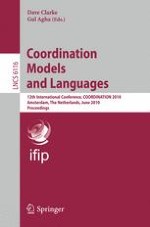2010 | Buch
Coordination Models and Languages
12th International Conference, COORDINATION 2010, Amsterdam, The Netherlands, June 7-9, 2010. Proceedings
herausgegeben von: Dave Clarke, Gul Agha
Verlag: Springer Berlin Heidelberg
Buchreihe : Lecture Notes in Computer Science
